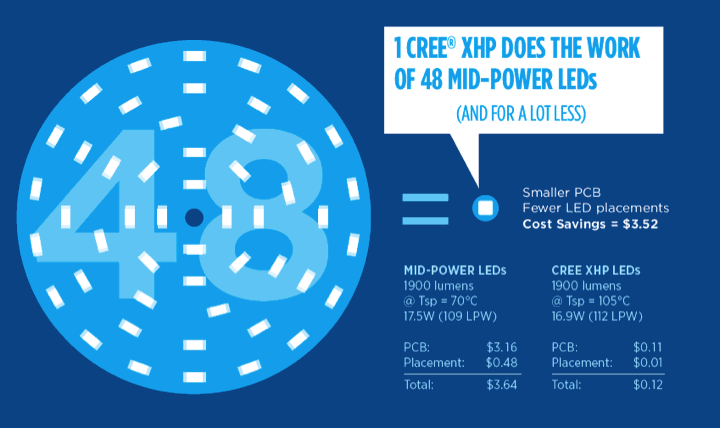It’s been a little while since we’ve heard of new developments coming out of Cree but their newest XHP series LED is bound to make some jaws drop on specs alone. The new Cree XHP finally has a name that stands for something, Extreme High Power, and by all metrics this is one of the single brightest commercial LEDs ever made available.
 Remember how floored we were by the Cree XML several years ago for being able to run up to 10 watts and keeping more than 100 lumen per watt efficicency at 7 watts? The new Cree XHB obliterates those records with the ability to run at a mind-numbing 19 watts while still delivering more than 100 lumens per watt. That level of performance equates to more than 1900 lumens of bright white light emanating from a single minuscule 5 x 5mm light emitting diode.
Remember how floored we were by the Cree XML several years ago for being able to run up to 10 watts and keeping more than 100 lumen per watt efficicency at 7 watts? The new Cree XHB obliterates those records with the ability to run at a mind-numbing 19 watts while still delivering more than 100 lumens per watt. That level of performance equates to more than 1900 lumens of bright white light emanating from a single minuscule 5 x 5mm light emitting diode.
Not only is the new class of Cree XHB LEDs incredibly powerful, they are also built on a platform of Silicon Carbide wafer which makes for a more affordable chip, but also increases the LED’s thermal tolerance. All that power packed into such a small package could lead to thermal management issues but Cree claims their new breed of LED can withstand higher temperatures and drive currents while still preserving an L90 of 35,000 hours – that means 90% of initial brightness of the LEDs will remain after four years of continuous use!
 The Cree XHB LED and the new technologies it promises to introduces could lead to brighter and cheaper LED light fixtures for very high light applications, and with XHB, a true LED replacement for metal halide lighting could be on the horizon. However there are still plenty of technical hurdles for aquarists to overcome with the use of such powerful diodes, not the least of which is how to distribute all that light coming from such a small point source.
The Cree XHB LED and the new technologies it promises to introduces could lead to brighter and cheaper LED light fixtures for very high light applications, and with XHB, a true LED replacement for metal halide lighting could be on the horizon. However there are still plenty of technical hurdles for aquarists to overcome with the use of such powerful diodes, not the least of which is how to distribute all that light coming from such a small point source.
Samples of the promising new Cree XHB diodes have yet to start shipping and we know next to nothing about what colors and bins of the 19-watt capable diode will be like, or how much they will cost. Blue versions of the new XHB will likely come well after the white versions, if at all, but in the meantime we are comforted to know that LEDs are continuing their steady march towards becoming the light engines of the future. [Cree ]



